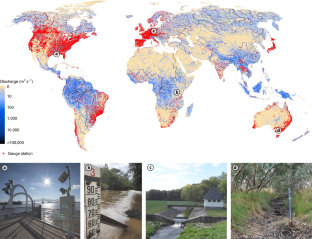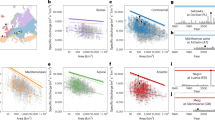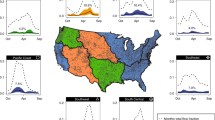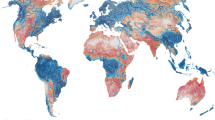Abstract
Knowing where and when rivers flow is paramount to managing freshwater ecosystems. Yet stream gauging stations are distributed sparsely across rivers globally and may not capture the diversity of fluvial network properties and anthropogenic influences. Here we evaluate the placement bias of a global stream gauge dataset on its representation of socioecological, hydrologic, climatic and physiographic diversity of rivers. We find that gauges are located disproportionally in large, perennial rivers draining more human-occupied watersheds. Gauges are sparsely distributed in protected areas and rivers characterized by non-perennial flow regimes, both of which are critical to freshwater conservation and water security concerns. Disparities between the geography of the global gauging network and the broad diversity of streams and rivers weakens our ability to understand critical hydrologic processes and make informed water-management and policy decisions. Our findings underscore the need to address current gauge placement biases by investing in and prioritizing the installation of new gauging stations, embracing alternative water-monitoring strategies, advancing innovation in hydrologic modelling, and increasing accessibility of local and regional gauging data to support human responses to water challenges, both today and in the future.
This is a preview of subscription content, access via your institution
Access options
Access Nature and 54 other Nature Portfolio journals
Get Nature+, our best-value online-access subscription
$29.99 / 30 days
cancel any time
Subscribe to this journal
Receive 12 digital issues and online access to articles
$119.00 per year
only $9.92 per issue
Buy this article
- Purchase on Springer Link
- Instant access to full article PDF
Prices may be subject to local taxes which are calculated during checkout




Similar content being viewed by others
Data availability
All data from this study are available at https://doi.org/10.17605/OSF.IO/NYA8R.
Code availability
R scripts used in this study are available from the Dry Rivers GitHub page at https://github.com/dry-rivers-rcn/G4.
References
Vörösmarty, C. J. et al. Global threats to human water security and river biodiversity. Nature 467, 555–561 (2010).
Ruhi, A., Messager, M. L. & Olden, J. D. Tracking the pulse of the Earth’s fresh waters. Nat. Sustain. 1, 198–203 (2018).
Pearson, C. Short- and medium-term climate information for water management. World Meteorol. Organ. Bull. 57, 173–177 (2008).
Tetzlaff, D., Carey, S. K., McNamara, J. P., Laudon, H. & Soulsby, C. The essential value of long-term experimental data for hydrology and water management. Water Resour. Res. 53, 2598–2604 (2017).
Carlisle, D. M., Wolock, D. M. & Meador, M. R. Alteration of streamflow magnitudes and potential ecological consequences: a multiregional assessment. Front. Ecol. Environ. 9, 264–270 (2011).
Shrestha, S., Kazama, F. & Newham, L. T. H. A framework for estimating pollutant export coefficients from long-term in-stream water quality monitoring data. Environ. Model. Softw. 23, 182–194 (2008).
Lepistö, A., Futter, M. N. & Kortelainen, P. Almost 50 years of monitoring shows that climate, not forestry, controls long-term organic carbon fluxes in a large boreal watershed. Glob. Change Biol. 20, 1225–1237 (2014).
Hester, G., Ford, D., Carsell, K., Vertucci, C. & Stallings, E. A. Flood Management Benefits of USGS Streamgaging Program (National Hydrologic Warning Council, 2006).
Xu, H., Xu, C.-Y., Chen, H., Zhang, Z. & Li, L. Assessing the influence of rain gauge density and distribution on hydrological model performance in a humid region of China. J. Hydrol. 505, 1–12 (2013).
Kiang, J. E., Stewart, D. W., Archfield, S. A., Osborne, E. B. & Eng, K. A National Streamflow Network Gap Analysis (USGS, 2013).
Deweber, J. T. et al. Importance of understanding landscape biases in USGS gage locations: implications and solutions for managers. Fisheries 39, 155–163 (2014).
Tickner, D. et al. Bending the curve of global freshwater biodiversity loss: an emergency recovery plan. BioScience 70, 330–342 (2020).
Grill, G. et al. Mapping the world’s free-flowing rivers. Nature 569, 215–221 (2019).
Olden, J. D. et al. Hydrologic classification of Tanzanian rivers to support national water resource policy. Ecohydrology. https://doi.org/10.1002/eco.2282 (2021).
Lin, P. et al. Global reconstruction of naturalized river flows at 2.94 million reaches. Water Resour. Res. 55, 6499–6516 (2019).
Yamazaki, D. et al. MERIT Hydro: a high-resolution global hydrography map based on latest topography dataset. Water Resour. Res. 55, 5053–5073 (2019).
Beck, H. E. et al. Bias correction of global high-resolution precipitation climatologies using streamflow observations from 9,372 catchments. J. Clim. 33, 1299–1315 (2020).
Do, H. X., Gudmundsson, L., Leonard, M. & Westra, S. The Global Streamflow Indices and Metadata Archive (GSIM)—part 1: the production of a daily streamflow archive and metadata. Earth Syst. Sci. Data 10, 765–785 (2018).
Linke, S. et al. Global hydro-environmental sub-basin and river reach characteristics at high spatial resolution. Sci. Data 6, 283 (2019).
Dobrushin, R. L. Prescribing a system of random variables by conditional distributions. Theory Probab. Appl. 15, 458–486 (1970).
Schefzik, R., Flesch, J. & Goncalves, A. Fast identification of differential distributions in single-cell RNA-sequencing data with waddR. Bioinformatics 37, 3204–3211 (2021).
Reid, A. J. et al. Emerging threats and persistent conservation challenges for freshwater biodiversity. Biol. Rev. 94, 849–873 (2019).
Wittemyer, G., Elsen, P., Bean, W. T., Burton, A. C. O. & Brashares, J. S. Accelerated human population growth at protected area edges. Science 321, 123–126 (2008).
Colvin, S. A. R. et al. Headwater streams and wetlands are critical for sustaining fish, fisheries, and ecosystem Services. Fisheries 44, 73–91 (2019).
Chen, K. & Olden, J. D. Threshold responses of riverine fish communities to land use conversion across regions of the world. Glob. Change Biol. 26, 4952–4965 (2020).
Pardo, I. et al. The European reference condition concept: a scientific and technical approach to identify minimally-impacted river ecosystems. Sci. Total Environ. 420, 33–42 (2012).
Sauquet, E. et al. Classification and trends in intermittent river flow regimes in Australia, northwestern Europe and USA: a global perspective. J. Hydrol. 597, 126170 (2021).
Creed, I. F. et al. Enhancing protection for vulnerable waters. Nat. Geosci. 10, 809–815 (2017).
Abell, R. et al. Freshwater ecoregions of the world: a new map of biogeographic units for freshwater biodiversity conservation. BioScience 58, 403–414 (2008).
Wilhite, D. A. in Coping with Drought Risk in Agriculture and Water Supply Systems: Drought Management and Policy Development in the Mediterranean, Vol. 26 (eds. Iglesias, A. et al.) 3–19 (Springer Science and Business Media, 2009).
Winemiller, K. O. et al. Balancing hydropower and biodiversity in the Amazon, Congo, and Mekong. Science 351, 128–129 (2016).
Seyfried, M. S. & Wilcox, B. P. Scale and the nature of spatial variability: field examples having implications for hydrologic modeling. Water Resour. Res. 31, 173–184 (1995).
Hammond, J. C. et al. Spatial patterns and drivers of nonperennial flow regimes in the contiguous United States. Geophys. Res. Lett. 48, e2020GL090794 (2021).
Messager, M. L. et al. Global prevalence of non-perennial rivers and streams. Nature 594, 391–397 (2021).
Busch, M. H. et al. What’s in a name? Patterns, trends, and suggestions for defining non-perennial rivers and streams. Water 12, 1980 (2020).
Zipper, S. C. et al. Pervasive changes in stream intermittency across the United States. Environ. Res. Lett. 16, 084033 (2021).
Jaeger, K. L., Olden, J. D. & Pelland, N. A. Climate change poised to threaten hydrologic connectivity and endemic fishes in dryland streams. Proc. Natl Acad. Sci. USA 111, 13894–13899 (2014).
Beaufort, A., Lamouroux, N., Pella, H., Datry, T. & Sauquet, E. Extrapolating regional probability of drying of headwater streams using discrete observations and gauging networks. Hydrol. Earth Syst. Sci. 22, 3033–3051 (2018).
Argerich, A. et al. Comprehensive multiyear carbon budget of a temperate headwater stream: carbon budget of a headwater stream. J. Geophys. Res. Biogeosci. 121, 1306–1315 (2016).
Molden, D. J., Shrestha, A. B., Nepal, S. & Immerzeel, W. W. in Water Security, Climate Change and Sustainable Development (eds. Biswas, A. K. & Tortajada, C.) 65–82 (Springer, 2016).
Kaletová, T. et al. Relevance of intermittent rivers and streams in agricultural landscape and their impact on provided ecosystem services—a Mediterranean case study. Int. J. Environ. Res. Public Health 16, 2693 (2019).
Zimmer, M. A. et al. Zero or not? Causes and consequences of zero-flow stream gage readings. WIREs Water 7, e1436 (2020).
Wine, M. L. Toward strong science to support equitable water sharing in securitized transboundary watersheds. Biologia 9, 907–915 (2020).
Alsdorf, D. E. GEOPHYSICS: tracking fresh water from space. Science 301, 1491–1494 (2003).
Benstead, J. P. & Leigh, D. S. An expanded role for river networks. Nat. Geosci. 5, 678–679 (2012).
Allen, D. C. et al. Citizen scientists document long-term streamflow declines in intermittent rivers of the desert southwest, USA. Freshw. Sci. https://doi.org/10.1086/701483 (2019).
Joo, H. et al. Optimal stream gauge network design using entropy theory and importance of stream gauge stations. Entropy 21, 991 (2019).
Vörösmarty, C. et al. Global water data: a newly endangered species. Eos 82, 54–58 (2001).
Jordahl, K. et al. Geopandas/geopandas. Zenodo https://doi.org/10.5281/zenodo.3946761 (2020).
Lin, P., Pan, M., Wood, E. F., Yamazaki, D. & Allen, G. H. A new vector-based global river network dataset accounting for variable drainage density. Sci. Data 8, 28 (2021).
Yu, S. et al. Evaluating a landscape-scale daily water balance model to support spatially continuous representation of flow intermittency throughout stream networks. Hydrol. Earth Syst. Sci. 24, 5279–5295 (2020).
Kennard, M. J. et al. Classification of natural flow regimes in Australia to support environmental flow management. Freshw. Biol. 55, 171–193 (2010).
Flow/No Flow Observations with Discharge Data from Probabilistic Stream Surveys (US EPA Office of Research and Development, 2021).
Rosenbaum, P. R. & Rubin, D. B. The bias due to incomplete matching. Biometrics 41, 103–116 (1985).
Acknowledgements
This manuscript is a product of the Dry Rivers Research Coordination Network, which was supported by funding from the US National Science Foundation (DEB-1754389 and 2207232 to D.C.A.). Although this work was reviewed by the USEPA and approved for publication, it does not necessarily reflect official USEPA policy. This work has been peer reviewed and approved for publication consistent with USGS Fundamental Science Practices (https://pubs.usgs.gov/circ/1367/). Any use of trade, firm or product names is for descriptive purposes only and does not imply endorsement by the US government.
Author information
Authors and Affiliations
Contributions
G.H.A., J.D.O., C.A.K., S.E.G., P.L., R.M.B., A.G.D., D.C.A., K.M.F., M.S., M.A.Z., T.D., W.K.D., C.N.J., J.C.H., M.C.M., S.Z., A.J.B., K.H.C. and A.S.W. conceived the study. P.L., H.E.B., K.M.F. and M.S. contributed data. J.D.O., G.H.A., P.L., C.A.K., C.F. and C.N.J. conducted analyses. G.H.A., J.D.O., C.A.K. and P.L. constructed visualizations. C.A.K., J.D.O., G.H.A. and S.E.G. drafted the manuscript, and all authors reviewed and edited the manuscript.
Corresponding author
Ethics declarations
Competing interests
The authors declare no competing interests.
Peer review
Peer review information
Nature Sustainability thanks Jefferson DeWeber, Hong Do and Yin-phan Tsang for their contribution to the peer review of this work.
Additional information
Publisher’s note Springer Nature remains neutral with regard to jurisdictional claims in published maps and institutional affiliations.
Supplementary information
Supplementary Information
Supplementary Figs. 1–4, Tables 1–3 and Methods.
Rights and permissions
About this article
Cite this article
Krabbenhoft, C.A., Allen, G.H., Lin, P. et al. Assessing placement bias of the global river gauge network. Nat Sustain 5, 586–592 (2022). https://doi.org/10.1038/s41893-022-00873-0
Received:
Accepted:
Published:
Issue Date:
DOI: https://doi.org/10.1038/s41893-022-00873-0
This article is cited by
-
Uncertain Benefits of Using Remotely Sensed Evapotranspiration for Streamflow Estimation—Insights From a Randomized, Large-Sample Experiment
Water Resources Management (2024)
-
Identifying Potential Locations of Hydrologic Monitoring Stations Based on Topographical and Hydrological Information
Water Resources Management (2024)
-
Functional relationships reveal differences in the water cycle representation of global water models
Nature Water (2023)
-
Restructuring and serving web-accessible streamflow data from the NOAA National Water Model historic simulations
Scientific Data (2023)
-
Non-perennial segments in river networks
Nature Reviews Earth & Environment (2023)



